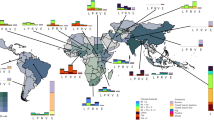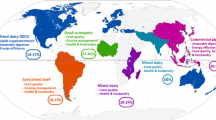Abstract
Livestock production systems will inevitably be affected as a result of changes in climate and climate variability, with impacts on peoples’ livelihoods. At the same time, livestock food chains are major contributors to greenhouse gas emissions. Agriculture and livestock in particular will need to play a greater role than they have hitherto in reducing emissions in the future. Adaptation and mitigation may require significant changes in production technology and farming systems, which could affect productivity. Given what is currently known about the likely impacts on livestock systems, however, the costs of mitigating and adapting to climate change in the aggregate may not represent an enormous constraint to the growth of the global livestock sector, in its bid to meet increasing demand for livestock products. Different livestock systems have different capacities to adapt or to take on board the policy and regulatory changes that may be required in the future. Vulnerability of households dependent on livestock, particularly in the drier areas of developing countries, is likely to increase substantially, with concomitant impacts on poverty and inequity. The capacity of these systems to adapt and to yield up their carbon sequestration potential deserves considerable further study. Comprehensive frameworks need to be developed to assess impacts and trade-offs, in order to identify and target adaptation and mitigation options that are appropriate for specific contexts, and that can contribute to environmental sustainability as well as to poverty alleviation and economic development.
Similar content being viewed by others
References
Agrawala S, Fankhauser S (2008) Economic aspects of adaptation to climate change: costs, benefits and policy instruments. OECD Publications
Asner GP, Elmore AJ, Olander LP, Martin RE, Harris AT (2004) Grazing systems, ecosystem responses, and global change. Annu Rev Environ Resour 29:261–299
Barrett CB, Carter MR, McPeak J, Mude A (2008) Altering poverty dynamics with index insurance: Northern Kenya’s HSNP+. BASIS Brief 2008-08. University of Wisconsin, Madison. <www.basis.wisc.edu/live/amabrief08-08.pdf>
Baylis M, Githeko AK (2006) The effects of climate change on infectious diseases of animals. Report for the Foresight Project on Detection of Infectious Diseases, Department of Trade and Industry, UK Government, p 35
Blench R, Marriage Z (1999) Drought and livestock in semi-arid Africa and southwest Asia. Working Paper 117, Overseas Development Institute, London, p. 138
Burke MB, Lobell DB, Guarino L (2009) Shifts in African crop climates by 2050, and the implications for crop improvement and genetic resources conservation. Global Environmental Change, doi:10.1016/j.gloenvcha.2009.04.003
Capper JL, Cady RA, Bauman DE (2009) The environmental impact of dairy production: 1944 compared with 2007. J Anim Sci 87:2160–2167
CGRFA (Commission on Genetic Resources for Food and Agriculture) (2007) The state of the world’s animal genetic resources for food and agriculture. FAO, Rome, p 523
Chadd S (2007) Future trends and developments in poultry nutrition. Poultry in the 21st century: Avian influenza and beyond. International Poultry Conference, Bangkok, November 2007. Online at http://www.fao.org/AG/againfo/home/events/bangkok2007/docs/part1/1_7.pdf
Challinor A, Wheeler T, Garforth C, Craufurd P, Kassam A (2007) Assessing the vulnerability of food crop systems in Africa to climate change. Clim Change 83:381–399
Challinor AJ, Ewert F, Arnold S, Simelton E, Fraser E (2009) Crops and climate change: progress, trends, and challenges in simulating impacts and informing adaptation. Journal of Experimental Botany, doi:10.1093/jxb/erp062
Delgado C (2005) Rising demand for meat and milk in developing countries: implications for grasslands-based livestock production. In: McGilloway DA (ed) Grassland: a global resource. Wageningen Academic, The Netherlands, pp 29–39
FAO (2007) The state of food and agriculture. Paying farmers for environmental services. FAO, Rome
Füssel H-M (2007) Vulnerability: a generally applicable conceptual framework for climate change research. Glob Environ Change 17:155–167
Gerber PJ, Carsjens GJ, Pak-uthai T, Robinson TP (2008) Decision support for spatially targeted livestock policies: diverse examples from Uganda and Thailand. Agric Syst 96:37–51
Gerber PJ, Mooney H, Dijkman J, Tarawali S, de Haan C (2009) Cross-cutting observations and conclusions. Livestock in a changing landscape: experiences and regional perspectives. Island Press, Washington DC (in press)
HDR (Human Development Report) (2007) Human Development Report 2007/2008. Fighting climate change: human solidarity in a divided world. UNDP, New York
Hellmuth ME, Moorhead A, Thomson M, Williams J (2007) Climate risk management in Africa: Learning from practice. Climate and Society Issue #1. The International Research Institute for Climate and Society (IRI), Palisades
Herrero M, Thornton PK, Notenbaert A, Msangi S, Wood S, Kruska RL, Dixon J, Bossio D, van de Steeg JA, Freeman HA, Li X, Rao PP (2009) Drivers of change in crop-livestock systems and their potential impacts on agro-ecosystems services and human well-being to 2030. Study commissioned by the CGIAR Systemwide Livestock Programme (SLP). ILRI, Nairobi
Hobbs NT, Galvin KA, Stokes CJ, Lackett JM, Ash AJ, Boone RB, Reid RS, Thornton PK (2008) Fragmentation of rangelands: implications for humans, animals, and landscapes. Glob Environ Change 18:776–785
Hoffman MT, Vogel C (2008) Climate change impacts on African rangelands. Rangelands 30:12–17
IPCC (Intergovernmental Panel on Climate Change) (2000) Land use, land-use change, and forestry. Cambridge University Press, Cambridge
IPCC (Intergovernmental Panel on Climate Change) (2007) In: Parry ML, Canziani OF, Palutikof JP, van der Linden PJ, Hanson CE (eds) Climate change 2007: impacts, adaptation and vulnerability. Contribution of working group II to the fourth assessment report of the intergovernmental panel on climate change. Cambridge University Press, Cambridge, p 976
Jones PG, Thornton PK (2003) The potential impacts of climate change in tropical agriculture: the case of maize in Africa and Latin America in 2055. Glob Environ Change 13:51–59
Jones PG, Thornton PK (2009) Croppers to livestock keepers: Livelihood transitions to 2050 in Africa due to climate change. Environ Sci Policy 12:427–437
King DA, Peckham C, Waage JK, Brownlie J, Woolhouse MEJ (2006) Infectious diseases: preparing for the future. Science 313:1392–3
Kurukulasuriya P, Rosenthal S (2003) Climate change and agriculture: a review of impacts and adaptations. Climate Change Series Paper No. 91, World Bank, Washington DC.
Le Houérou HN, Bingham RL, Skerbek W (1988) Relationship between the variability of primary production and the variability of annual precipitation in world arid lands. J Arid Environ 15:1–18
MA (2005) The millennium ecosystem assessment, ecosystems and Human well-being: scenarios, Volume 2, Island Press, 2005. Online at http://www.maweb.org//en/products.global.scenarios.aspx.
McAlpine CA, Etter A, Fearnside PM, Seabrook L, Laurance WF (2009) Increasing world consumption of beef as a driver of regional and global change: A call for policy action based on evidence from Queensland (Australia), Colombia and Brazil. Global Environmental Change (in press), doi:10.1016/j.gloenvcha.2008.10.008
McMichael AJ, Powles JW, Butler CD, Uauy R (2007) Food, livestock production, energy, climate change, and health. The Lancet, 13 September 2007
Minson DJ (1990) Forage in ruminant nutrition. Academic, San Diego
Morgan JA, Milchunas DG, LeCain DR, West M, Mosier AR (2007) Carbon dioxide enrichment alters plant community structure and accelerates shrub growth in the shortgrass steppe. PNAS 104:14724–14729
Mude A (2009) Index-based livestock insurance for northern Kenya’s arid and semi-arid lands: the Marsabit pilot. Project document, ILRI, Nairobi, p 14
Nelson GC, Rosegrant MW, Koo J, Robertson R, Sulser T, Zhu T, Ringler C, Msangi S, Palazzo A, Batja M, Magalhaes M, Valmonte-Santos R, Ewing M, Lee D (2009) Climate change: impact on agriculture and costs of adaptation. Food Policy Report, IFPRI, Washington DC
O’Brien K, Eriksen S, Schjolden A, Nygaard L (2004) What’s in a word? Conflicting interpretations of vulnerability in climate change research. CICERO Working Paper 2004:04, Centre for International Climate and Environmental Research, Oslo
OECD-FAO (2008) Agricultural Outlook 2008–2017. OECD, Paris
Patz JA, Campbell-Lendrum D, Holloway T, Foley JA (2005). Impact of regional climate change on human health. Nature 438 (November), 310–317.
Randolph SE (2008) Dynamics of tick-borne disease systems: minor role of recent climate change. Revue Scientifique et Technique. Off Int Epizoot 27(2):367–381
Reid RS, Thornton PK, McCrabb GJ, Kruska RL, Atieno F, Jones PG (2004) Is it possible to mitigate greenhouse gas emissions in pastoral ecosystems of the tropics? Environ Dev Sustain 6:91–109
Rosegrant MW, Cai X, Cline SA (2002) Global water outlook to 2025, averting an impending crisis. A 2020 vision for food, agriculture, and the environment initiative. IFPRI and IWMI
Rosegrant MW, Fernandez M, Sinha A, Alder J, Ahammad H, de Fraiture C, Eickhout B, Fonseca J, Huang J, Koyama O, Omezzine AM, Pingali P, Ramirez R, Ringler C, Robinson S, Thornton P, van Vuuren D, Yana-Shapiro H (2009). Looking into the future for agriculture and AKST (Agricultural Knowledge Science and Technology). Chapter 5 (pp 307-376) in Agriculture at a Crossroads (eds. BD McIntyre, HR Herren, J Wakhungu, RT Watson), Island Press, Washington DC.
Rötter R, van de Geijn SC (1999) Climate change effects on plant growth, crop yield and livestock. Clim Change 43:651–681
Skees JR, Enkh-Amgalan A (2002) Examining the feasibility of livestock insurance in Mongolia. Policy Research Working Paper 2886, World Bank, Washington DC
Smith P, Martino D, Cai Z, Gwary D, Janzen H, Kumar P, McCarl B, Ogle S, O’Mara F, Rice C, Scholes B, Sirotenko O (2007) Agriculture. In: Metz B, Davidson OR, Bosch PR, Dave R, Meyer LA, Metz B, Davidson OR, Bosch PR, Dave R, Meyer LA (eds) Climate change 2007: mitigation. Contribution of working group III to the fourth assessment report of the intergovernmental panel on climate change. Cambridge University Press, Cambridge
Sperling L (1987) The adoption of camels by Samburu cattle herders. Nomad Peoples 23:1–18
Steinfeld H, Gerber P, Wassenaar T, Castel V, Rosales M, de Haan C (2006) Livestock’s long shadow: environmental issues and options. FAO, Rome
Thornton PK, Jones PG, Owiyo T, Kruska RL, Herrero M, Kristjanson P, Notenbaert A, Bekele N, Omolo A, with contributions from Orindi V, Ochieng A, Otiende B, Bhadwal S, Anantram K, Nair S, Kumar V, Kelkar U (2006) Mapping climate vulnerability and poverty in Africa. Report to the Department for International Development, ILRI, Nairobi, Kenya, May 2006, 200 pp. Online at http://www.dfid.gov.uk/research/mapping-climate.pdf
Thornton PK, van de Steeg J, Notenbaert A, Herrero M (2009) The impacts of climate change on livestock and livestock systems in developing countries: a review of what we know and what we need to know. Agric Syst 101:113–127
UNDP (United Nations Development Programme) (2008) Human Development Report 2007/2008: fighting climate change: human solidarity in a divided world. New York, USA
UNFCCC (2008) Challenges and opportunities for mitigation in the agricultural sector: technical paper. United Nation Framework Convention on Climate Change. Online at http://unfccc.int/resource/docs/2008/tp/08.pdf
Washington R, Harrison M, Conway D, Black E, Challinor A, Grimes D, Jones R, Morse A, Kay G, Todd M (2006) African climate change: taking the shorter route. Bull Am Meteorol Soc 87:1355–1366
Wilby RL, Troni J, Biot Y, Tedd L, Hewitson BC, Smith DM, Sutton RT (2009) A review of climate risk information for adaptation and development planning. International Journal of Climatology, online at doi:10.1002/joc.1839
Acknowledgements
The authors thank Ade Freeman, Mario Herrero, and three anonymous reviewers for helpful comments on an earlier version of this paper. Remaining errors and omissions are our responsibility.
Author information
Authors and Affiliations
Corresponding author
Rights and permissions
About this article
Cite this article
Thornton, P.K., Gerber, P.J. Climate change and the growth of the livestock sector in developing countries. Mitig Adapt Strateg Glob Change 15, 169–184 (2010). https://doi.org/10.1007/s11027-009-9210-9
Received:
Accepted:
Published:
Issue Date:
DOI: https://doi.org/10.1007/s11027-009-9210-9




